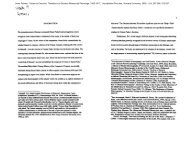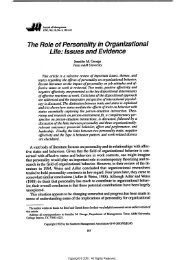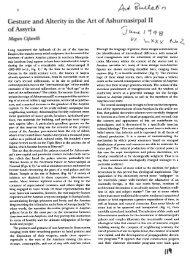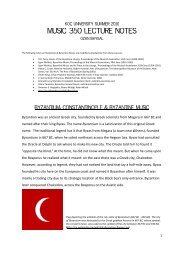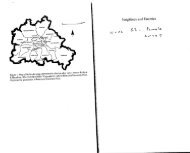The Hattian and Hittite Civilizations
The Hattian and Hittite Civilizations
The Hattian and Hittite Civilizations
You also want an ePaper? Increase the reach of your titles
YUMPU automatically turns print PDFs into web optimized ePapers that Google loves.
<strong>The</strong> Smail Kingdoms Period in Anatolia in the First<br />
Millennium BC<br />
Inthe Iron Age (1200 - 750/700 BC) the Anatolian peninsula was nıled by principalities<br />
of various sizes, as it had been in the first quarter of the 2nd millennium BC. In<br />
southem Anatolia <strong>and</strong> Syria the Late Bittites, in eastem Anatolia the Urartu, an extension<br />
of the Hurrians, in central AnatoHathe Phrygians <strong>and</strong> Lydians, in southwestem AnatoHa<br />
the Lykians <strong>and</strong> in the Aegean the Ionians all ereated civilizations of superiOliquality. <strong>The</strong>se<br />
groups, together with the Egyptians, the Phoenicians <strong>and</strong> the Babylonians had strong<br />
influenees on Hellene eivilization <strong>and</strong> made important eontributions to the world eulture of<br />
today.<br />
With the destroetion of Hattusha around 1200 BC <strong>Hittite</strong> eulture in Anatolia was extinguished,<br />
for eultural aetivity had not reaehed the eommon people but was confined to the<br />
palaee <strong>and</strong> a narrow circle of aristoerats. In eontrast, the <strong>Hittite</strong> tradition eontinued to exist<br />
in southeastem Anatolia <strong>and</strong> northern Mesopotamia, whieh had aıready eome under the<br />
influenee of <strong>Hittite</strong> civilization throughout the latter half of the 2nd millennium BC. In this<br />
region, whose population was essentially of Luwian origin, the artwork that we know from<br />
Hattusha, Alaeahöyük <strong>and</strong> many other areas of Anatolia now took on new forms.<br />
In these principalities, formed of dozens of eity states, it is possible to distinguish four<br />
main artistic styles: 1) <strong>The</strong> Traditional <strong>Hittite</strong> Style I <strong>and</strong> Il; 2) Late <strong>Hittite</strong> Style under<br />
Assyrian influenee; 3) Late Bittite Style under Aramaean <strong>and</strong> Assyrian influenee <strong>and</strong> 4) Late<br />
<strong>Hittite</strong> Style under Aramaean, Assyrian <strong>and</strong> Phoenician influenee.<br />
This style eontinues to a large degree that of the Imperial Period. So far it is seen only<br />
on the reliefs of the Aslantepe - Malatya city wall (Fig. 101-104,112) <strong>and</strong> in a religious stele<br />
also found in Malatya (Fig. 105).<br />
All the ieonographie details of the animal figures <strong>and</strong> symbols such as the headdress,<br />
garment, winged sun, the lituus (a seeptre like staff with a eurved end) of god <strong>and</strong> king<br />
figures are like those of works from Hattusha <strong>and</strong> Alaeahöyük. As in those of the Imperial<br />
Period, male figures are bearded or beardless but never mustaehed. An example is the<br />
Storm God at Malatya: exeept for eertain details of his bulls <strong>and</strong> chariot (Fig. 104) he is exactly<br />
like those of the Imperial Period. On the religious stele Kubaba is placed on the left <strong>and</strong><br />
the Storm God on the right, in accordanee with ancient <strong>Hittite</strong> protocol.<br />
Malatya. One of the lions from the gate in the relief-decorated city wall. 1050 - 850 BC.<br />
Museum of Anatolian CiviIizations, Ankara.<br />
<strong>The</strong> wall reliefs brought to light by English arehaeologists at Carehemish display two<br />
styles: 1) mythologieal seenes in the Traditional Style <strong>and</strong> 2) various seenes bearing Assyrian<br />
<strong>and</strong> Aramaean influenees (E. Akurgal, <strong>The</strong> Birth of Greek Aıt, London 196B, pp. 106 - 110).<br />
<strong>The</strong> human faees of Traditional Style il have an arresting appearance: large eyes <strong>and</strong><br />
ears, a large but attraetive aqui1ine nose, a ehin in proportion to the regular mouth <strong>and</strong> lips<br />
(Fig. 106, 129-131,137).<strong>The</strong> pompoms on their headdresses are larger than those in Style ı.<br />
<strong>The</strong> polos headdresses of the women are of the same dimensions as in Style I <strong>and</strong> are sometimes<br />
deeorated with rosettes, probably of gold. Our village women of today who decorate<br />
their headdresses with gold eoins are perhaps eontinuing an ancient Late <strong>Hittite</strong> custom.<br />
<strong>The</strong> ankle-length shawl (Fig. 107, 10B) that covers the head or polos <strong>and</strong> the baek, whiIe<br />
leaving the faee <strong>and</strong> front of the body open, is like the çarşaf of modern Turkish village<br />
women. This garment is a continuation of the Late <strong>Hittite</strong> fashion of Malatya, Carehemish,<br />
Maraş (Fig. 179, 1BO) <strong>and</strong> Urartu.<br />
<strong>The</strong> lion figures of Traditional Style I (Fig. 101, 112) <strong>and</strong> il (Fig. 113-116)continue the<br />
iconography of the Imperial Period.



